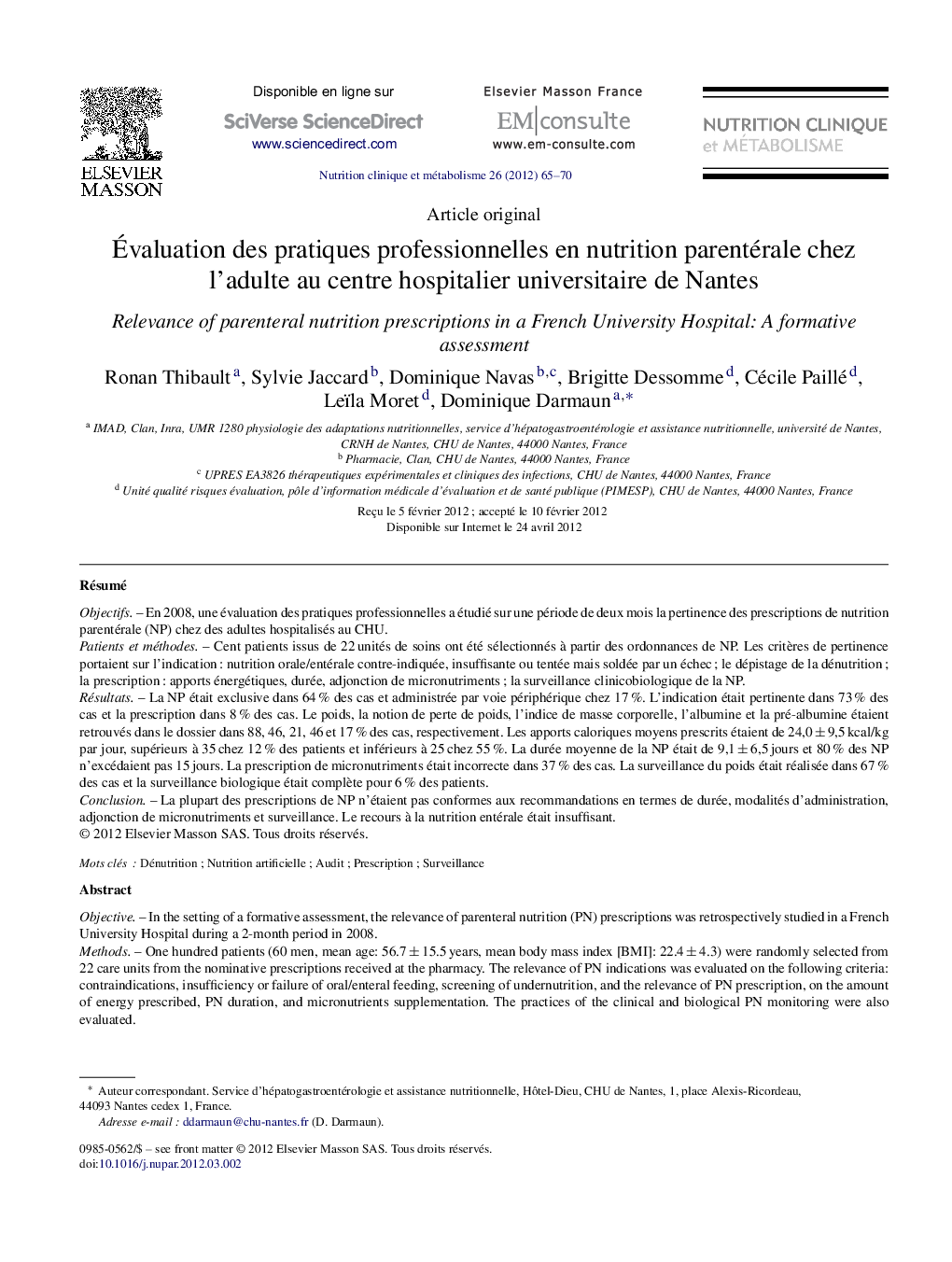| Article ID | Journal | Published Year | Pages | File Type |
|---|---|---|---|---|
| 2687364 | Nutrition Clinique et Métabolisme | 2012 | 6 Pages |
RésuméObjectifsEn 2008, une évaluation des pratiques professionnelles a étudié sur une période de deux mois la pertinence des prescriptions de nutrition parentérale (NP) chez des adultes hospitalisés au CHU.Patients et méthodesCent patients issus de 22 unités de soins ont été sélectionnés à partir des ordonnances de NP. Les critères de pertinence portaient sur l’indication : nutrition orale/entérale contre-indiquée, insuffisante ou tentée mais soldée par un échec ; le dépistage de la dénutrition ; la prescription : apports énergétiques, durée, adjonction de micronutriments ; la surveillance clinicobiologique de la NP.RésultatsLa NP était exclusive dans 64 % des cas et administrée par voie périphérique chez 17 %. L’indication était pertinente dans 73 % des cas et la prescription dans 8 % des cas. Le poids, la notion de perte de poids, l’indice de masse corporelle, l’albumine et la pré-albumine étaient retrouvés dans le dossier dans 88, 46, 21, 46 et 17 % des cas, respectivement. Les apports caloriques moyens prescrits étaient de 24,0 ± 9,5 kcal/kg par jour, supérieurs à 35 chez 12 % des patients et inférieurs à 25 chez 55 %. La durée moyenne de la NP était de 9,1 ± 6,5 jours et 80 % des NP n’excédaient pas 15 jours. La prescription de micronutriments était incorrecte dans 37 % des cas. La surveillance du poids était réalisée dans 67 % des cas et la surveillance biologique était complète pour 6 % des patients.ConclusionLa plupart des prescriptions de NP n’étaient pas conformes aux recommandations en termes de durée, modalités d’administration, adjonction de micronutriments et surveillance. Le recours à la nutrition entérale était insuffisant.
ObjectiveIn the setting of a formative assessment, the relevance of parenteral nutrition (PN) prescriptions was retrospectively studied in a French University Hospital during a 2-month period in 2008.MethodsOne hundred patients (60 men, mean age: 56.7 ± 15.5 years, mean body mass index [BMI]: 22.4 ± 4.3) were randomly selected from 22 care units from the nominative prescriptions received at the pharmacy. The relevance of PN indications was evaluated on the following criteria: contraindications, insufficiency or failure of oral/enteral feeding, screening of undernutrition, and the relevance of PN prescription, on the amount of energy prescribed, PN duration, and micronutrients supplementation. The practices of the clinical and biological PN monitoring were also evaluated.ResultsPN was total in 64%, and administered through a peripheral catheter in 17% of cases. Weight, weight loss, BMI, serum albumin and transthyretin were reported in the medical record in 88, 46, 21, 46, and 17% of cases, respectively. Mean total energy prescribed was 24.0 ± 9.5 kcal/kg per day, greater than 35 kcal/kg per day in 12% and less than 25 kcal/kg per day in 55% of patients. The mean duration of PN was 9.1 ± 6.5 days (range 1–35), and less than 15 days in 80% of cases. PN was administered without any micronutrient in 37% of cases. The weight and biological parameters were monitored in 67% and 6% of patients, respectively.ConclusionMost PN prescriptions are either irrelevant or inadapted regarding the duration, route of administration, monitoring, and micronutrients supplementation. The use of enteral nutrition is clearly insufficient.
